Castilla-La Mancha has a storied culinary history, but its restaurants have rarely been celebrated. For the second instalment of the 50 Best Explores Castilla-La Mancha travel series, Brazilian chef Manu Buffara joins 50 Best for a deep dive into the past, present and future of Manchegan gastronomy
El Bulli fundamentally changed how the world viewed Spanish gastronomy. Helmed by culinary icons Ferran and Albert Adrià, the landmark restaurant cemented Spain’s reputation as a global dining destination, hell-bent on pushing the boundaries of the culinary arts to ever-loftier heights.
The Adrià brothers’ restaurant may have closed in 2011, but its impact looms large. Whether directly through the trio of El Bulli alumni leading Disfrutar, now ranked No.2 in The World’s 50 Best Restaurants 2023, or via the wider cultural shift that sees discerning diners frequently travel to the Iberian peninsula in search of unforgettable meals, Spain has since earned its reputation as a titan of gastronomy.
Many areas of Spain were quick to capitalise on this. The Basque Country, Barcelona, Madrid and Galicia have each weaved their own identity in recent history through establishments that have reinvented their traditional gastronomic output. Conversely, Castilla-La Mancha, Spain’s third largest region, has largely missed out on such international recognition.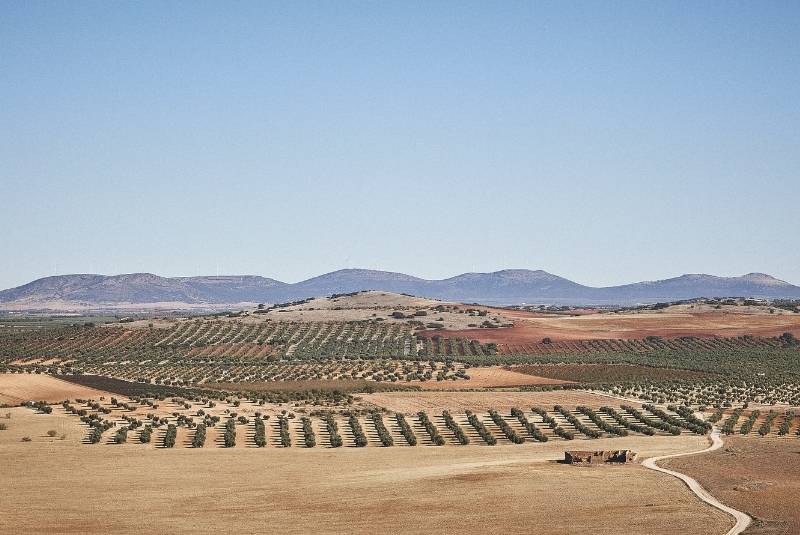
Castilla-La Mancha's fertile grounds and evolving gastronomy are still largely undiscovered
Castilla-La Mancha has always been a strong ingredient producer, where the culture and tradition of food is a simple affair. Its landscape is one of sprawling arid plateaus, intermittently interspersed with flowing rivers that carve a path through rocky hillsides, and its culinary identity is a natural reflection of this. Traditional dishes, agricultural practices and food offerings have steered clear of superfluity.
As a result, restaurants in the region have historically pooled from a range of traditional dishes, mostly unchanged over the centuries. But in recent years, buoyed by Spain’s gastronomic renaissance of the mid-2000s, chefs in the region have quietly begun to revolutionise Manchegan cuisine.
As Brazilian chef Manu Buffara arrives in Castilla-La Mancha ahead of a week-long gastronomic pilgrimage, she notes her knowledge of food from the region is limited to wine, olive oil and Manchego cheese production. She knows little of its restaurant scene in particular, and is ready to embark on a quest of discovery.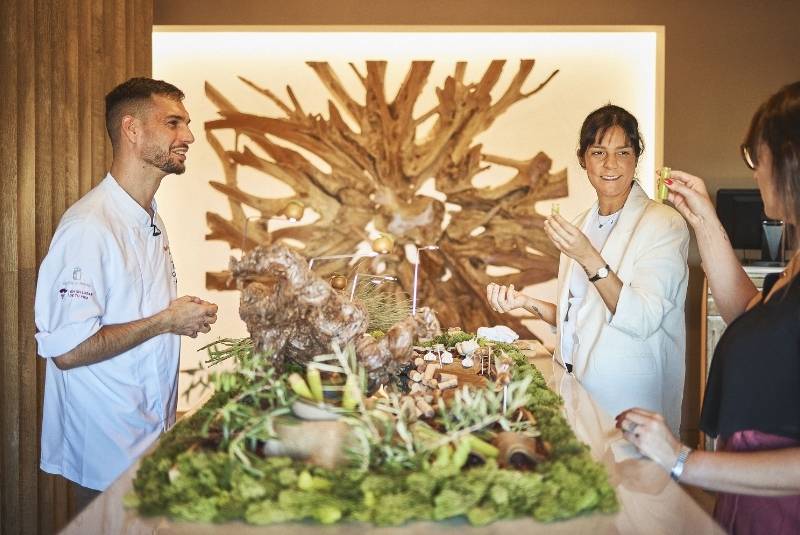
Buffara begins the gastronomic experience at restaurant Retama
In the foothills of the town of Torrenueva, Retama restaurant is home to chef Miguel Ángel Expósito’s reinterpretation of the region’s dishes. Expósito was born in Seville and trained in some of Spain’s finest kitchens, including The World’s 50 Best Restaurants mainstay Mugaritz, before moving to Castilla-La Mancha in 2019 and falling in love with its larder.
The interior of the restaurant employs a contemporary palette of stained wood and clean lines, injected with traditional regional design motifs of felled local olive trees and dried vines. Chef Expósito’s two tasting menus, titled The Tradition and La Retama, are both all-singing celebrations of regional delicacies, taking particular heed to the Arabic influences that come from its legacy as a historic battleground in centuries prior.
Guests begin their guided tour of the greatest hits of Manchegan produce with a garlic meringue, created from a local variety of the allium. A course of smoked sardine is paired with asadillo, a traditional rustic salad of tomatoes, peppers, olive oil and cumin, served instead as a cream. Further dishes dig deeper into the region’s repertoire, such as tiznao, a salt cod staple made with spring onions and peppers, both fresh and dried.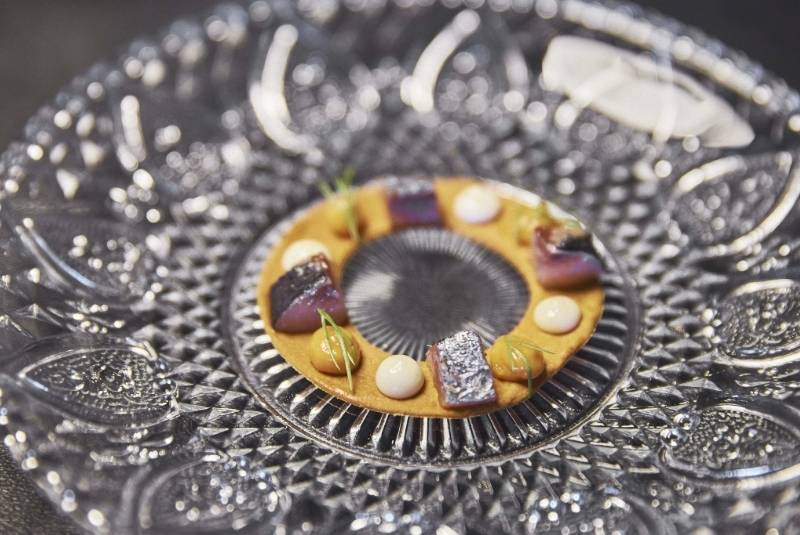
Smoked sardine with asadillo
“He’s working with new techniques but with classic dishes, using just local products,” says Buffara. Each bite is designed to deliver a familiar, comforting flavour profile, but in an entirely new medium.
Nearby, on a hilltop overlooking the quaint town of Torre de Juan Abad, chef José Antonio Medina follows a parallel path in his restaurant, El Coto de Quevedo. However, Medina chooses to platform the region’s traditions of pickling, foraging and game hunting as guiding principles in his own interpretation of Manchegan cuisine.
An appetiser of cured wild boar with foie gras is plated in a picture-perfect ensemble, topped with edible flowers: a far cry from its traditional presentation. A course of locally reared goat, which Buffara is invited to plate up on the pass, tips its hat to East Asia with an oyster sauce marination process. Each course is paired with wines produced within Castilla-La Mancha, chosen to maximise the terroir of the locality.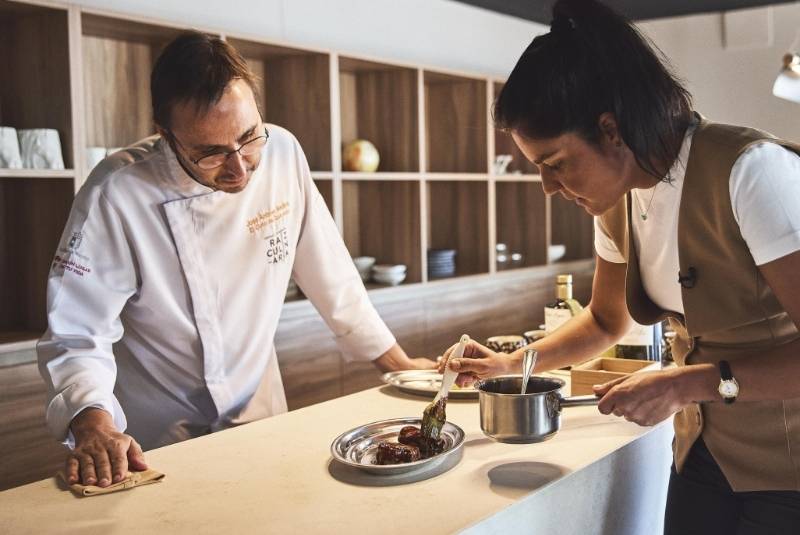
At El Coto de Quevedo, Buffara helps Medina brush the meat with sauce before it's roasted
“We have two chefs, 20 minutes between them, with totally different perspectives of the produce and food,” notes Buffara. “That's why we say gastronomy is so amazing.”
At Oba Restaurant in Casas-Ibáñez, joint head chefs Javier Sans and Juan Sahuquillo have embarked on a mission to represent and reintroduce the native Manchegan ingredients and foodstuffs that have been lost to history.
A course of Castilian rooster uses every element of the heritage bird, including its blood, to create a showcase in several forms. Celtiberian goat, an ancient species which narrowly avoided extinction by overhunting up to the 20th century, is also being gently reintroduced to the Manchegan diet by the duo.
As the chefs give Buffara a tour of the orchard and gardens that supply the restaurant, their dedication is further manifest. As they pass each vegetable, flower and ancient tuber, they explain the deep-rooted culture and history of each with passion and remarkable expertise. Beyond the modernist interpretations and aesthetics, Oba is about reconnecting the people of Castilla-La Mancha with the food that had sustained the region for centuries.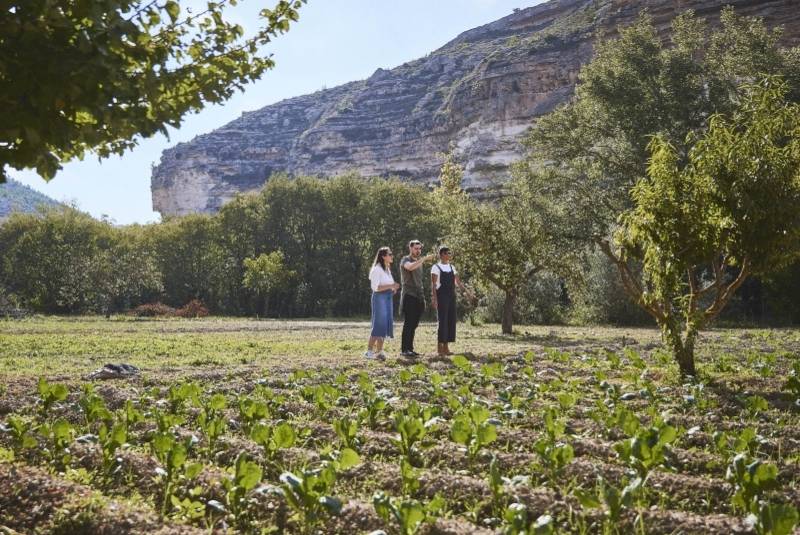
Sans and Sahuquillo grow much of the produce for their restaurant in their own orchard
“We stay in touch with nature,” says Sans, simply. As he describes it, everything used in the restaurant is ‘borrowed’ from the land the chefs have been tasked with looking after. The restaurant’s offering is highly dependent on the seasons, with due consideration to the impact that its use of produce will have on the wider ecosystem.
This mission of preservation extends beyond the region’s restaurants, too. Matamangos is an artisan winemaker, located on an estate near the town of Almansa. It’s a third-generation family affair, which specialises in indigenous and native grape varietals, specifically monastrell, garnacha and syrah.
“You can find cabernet sauvignon anywhere in the world,” says winemaker Carlos Gramage, stressing that unique qualities and flavour profiles can only be found in the grapes and resulting wines of the region. As Buffara picks a grape directly from the vine, she is drawn to its unique red flesh and noticeable sweetness, both rarities in wine grape varieties.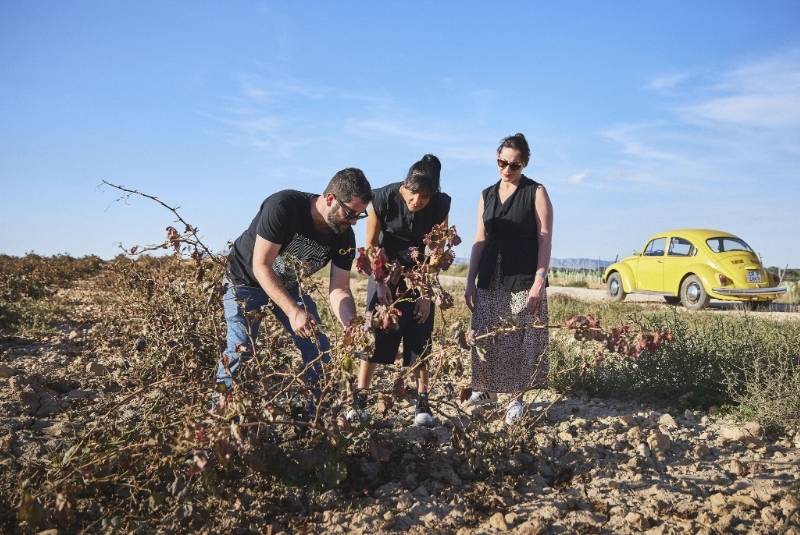
Tintorera grapes, which feature bright red pulp, are typical of Castilla-La Mancha
The excellence of Manchegan viniculture is not new for those within Spain, with the region often described as the winemaking capital of the country. But there’s now a burgeoning thirst from around the world for its unique flavour profile. “Almost 90 per cent of our business is exports,” says Gramage, a number set to increase as its international acclaim continues to grow.
As Buffara prepares to depart the region after a week sampling its food and wine, she traces the invisible thread that has tied every experience together. “I will remember the ingredients, the food and the wine,” Buffara says. “But the thing I will never forget is the people…how happy they are to show me where they come from.”
Until recently, Castilla-La Mancha had stood as an untapped vein of Spanish gastronomy, but it’s clear that its restaurants have found their calling. Every one of the leading gastronomic protagonists self-identifies as offering a modern spin on traditional Manchegan gastronomy, with limited outside influence.
And yet they are far from synonymous in their offering. Indeed, Buffara is never served the same dish twice over the course of the trip. Oba, Retama, El Coto de Quevedo and other top restaurants in the region may be pulling from the same culinary well, but that well is evidently deep enough to give much more.
Travel across Castilla-La Mancha with Manu Buffara in the video:
The third and final instalment of 50 Best Explores Castilla-La Mancha will take place from 23rd-27th October, when Jeremy Chan of London restaurant Ikoyi will explore the region’s autumnal offerings. Follow 50 Best Discovery on Instagram to follow the action live and browse the website for all travel inspiration.

